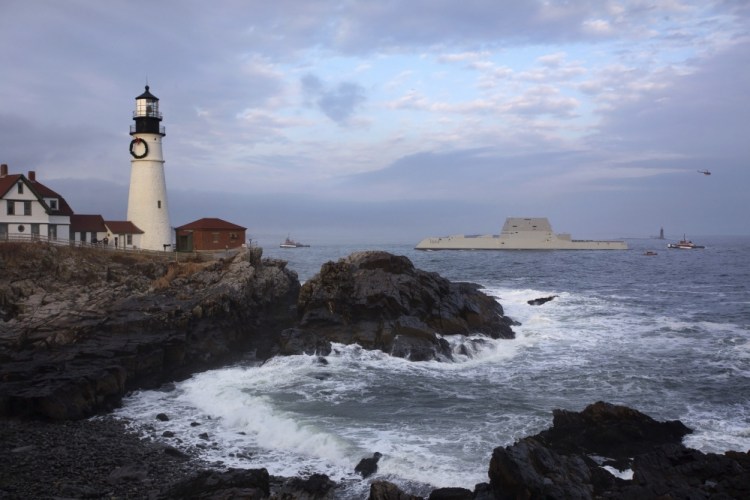BATH — In rare public comments, Bath Iron Works President Dirk Lesko spoke Monday evening about challenges facing the shipyard, caused largely by the Navy’s untimely reversal on the Zumwalt-class program.

Bath Iron Works President Dirk Lesko said the Zumwalt program “was very, very technically challenging.”
As the guest speaker at Main Street Bath’s annual meeting, Lesko said the Navy’s decision to truncate the Zumwalt-class destroyer program – on which BIW had focused all of its efforts – to just three ships had a lasting effect.
BIW delivers two classes of destroyers: The Arleigh Burke-class and the Zumwalt-class. The first of these has been the mainstay of the shipyard for 30 years.
“We delivered that lead ship in 1991 – 34 ships later, we delivered DDG 112” – the USS Michael Murphy, the 62nd ship in the Arleigh Burke class, Lesko said.
While the Arleigh Burke program was a profitable venture for BIW, as the shipyard entered the new millennium it was ready for the next generation of destroyers – and so was the Navy. The Navy announced that it would end construction of the Arleigh Burke destroyers and begin building 32 Zumwalt-class destroyers.
The Zumwalts were highly technical, highly advanced stealth ships. The destroyers were built to run on an electric system that could generate enough power to run a small city, and they were expected to be the host of futuristic weaponry, such as railguns or lasers. Their angular, pyramid-like shape would give them an advantage in sneaking up on the enemy – on radar, the 600-foot-long destroyer would look no larger than a small fishing vessel.
“In the years that led up to that contract, we worked to change the shipyard from DDG 51 (Arleigh Burke-class) construction to DDG 1000 (Zumwalt-class) construction. We changed the tools, our design practices, the way we planned the ship and the production work labor,” Lesko said.
The shipyard went through a massive transformation, he said, as it transitioned from building a ship designed in the 1980s to a ship designed in the new millennium.
Around the time BIW first signed its contract to build the Zumwalt-class destroyers, the Navy slashed its order to just three ships in order to reduce costs.

Cables secure the USS Zumwalt to a dock at the naval station in Newport, R.I., in 2016. The program was limited to production of only three ships.
“The problem with the (Zumwalt) program is that it was very, very technically challenging, which was not so much (an) issue that couldn’t be done, but that it was going to be very expensive,” Lesko said.
With the Zumwalt-class destroyer program limited to just three ships, the Navy restarted the Arleigh Burke-class program with some upgrades.
“The good news about the restart of the (Arleigh Burke) program is that we have something to build,” Lesko said. “It maintains our workforce at roughly the levels that we’re at.”
Still, the decision to limit the Zumwalt destroyers to just three ships carried significant ramifications for BIW’s work on the Arleigh Burke destroyers.
“We had for years prepared the shipyard to do something different,” Lesko said.
At the same time, the shipyard had lost through attrition many of the experienced hands who knew the Arleigh Burke destroyers inside and out. Workers also had to learn to build the older model of destroyers using new tools and design practices that were intended for Zumwalt construction. BIW effectively had to relearn how to construct the same ship it had been building since the 1980s.
“That has been very, very challenging for us,” Lesko said.
He didn’t have much to say about the shipyard’s future plans. At the moment, the Arleigh Burke program is still the shipyard’s mainstay. In the most recent contract competition, BIW was awarded four Arleigh Burke destroyers and its competing shipyard, Mississippi-based Huntington Ingalls, was awarded six. At the same time, the BIW is vying to build the Navy’s next class of frigates.
For now, Lesko takes pride in what BIW was able to accomplish in the Zumwalt series’ limited run.
“I’m amazed and humbled at what the workforce managed to do with the (Zumwalts),” Lesko said. “To deliver two of those ships at this point has been nothing short of remarkable.”
“We’re hopeful that as the Navy gets that hull form and uses it,” he said, “it may well be something that they use in a future service, so our efforts won’t have been in vain.”
Nathan Strout can be contacted at:
nstrout@timesrecord.com
Copy the Story LinkSend questions/comments to the editors.



Success. Please wait for the page to reload. If the page does not reload within 5 seconds, please refresh the page.
Enter your email and password to access comments.
Hi, to comment on stories you must . This profile is in addition to your subscription and website login.
Already have a commenting profile? .
Invalid username/password.
Please check your email to confirm and complete your registration.
Only subscribers are eligible to post comments. Please subscribe or login first for digital access. Here’s why.
Use the form below to reset your password. When you've submitted your account email, we will send an email with a reset code.